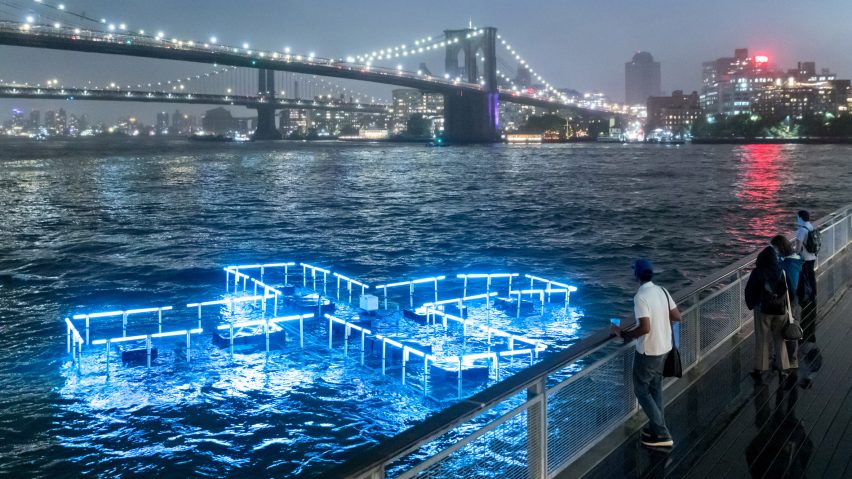LED lights on a plus-shaped installation floating on Manhattan's East River change colour based on the water quality conditions.
+ Pool Light is a public installation executed by local studios PlayLab Inc, Family New York, Floating Point, and Columbia University's Lamont-Doherty Earth Observatory. It tracks and reports the physical conditions of the water off Pier 17 in real-time.
Data collected is displayed on an online dashboard designed by Reaktor that reports whether or not the current water conditions are safe for swimming.
The drifting sculpture measures 50 by 50 feet (15 by 15 metres) and is constructed with a series of LED lights. Its cross-shape is influenced by the continued progress and efforts being made in New York City to improve water quality.
"The design recognises the "+" sign as a symbol of positivity, indicating the positive steps we have taken to improve water quality since the Clean Water Act of 1972," said Jeff Franklin, designer of + Pool Light and partner at PlayLab, Inc.
"Conceptually it is also a symbol of inclusivity in that the water that surrounds us belongs to no one single group, but to everyone."
The project was produced by Dong-Ping Wong and Oana Stanescu of Family New York, and Archie Lee Coates IV and Jeffrey Franklin of PlayLab, Inc. For several years, they have been working to design and install a floating, self-filtering swimming pool in a Manhattan river called + Pool to provide public, recreational space that is both fun and educational.
As part of the project, they established non-profit Friends of + Pool, which commissioned the light installation, to educate the public about water conditions in a way that is accessible and immersive.
"Water quality data is incredibly complex, so access to data means very little to everyday people," said Kara Meyer, managing director of Friends of + Pool. "We wanted to figure out a way to empower people with the data and engage them visually with what is happening in the water in front of them."
A series of sensors, part of a Fluidion Alert system, attach to the installation to take samples of the water, test and analyse them for levels of salinity, toxins and harmful pathogens.
Reaktor's dashboard powers the floating sculpture's lights. When levels of Enterococci, a bacteria Fluidion tests for, are safe for swimming + Pool Light glows teal, but if high levels of harmful pathogens are detected it turns pink, alerting the public that it isn't safe to enter the water.
The brightness, frequency and sharpness of the lights indicate the levels of oxygen, turbidity and pH present in the river.
The sculpture also changes its direction based off the flow of the current, moving clockwise when flowing north and counterclockwise when southbound.
+ Pool Light is on display in New York's Seaport District until 4 January 2020.
+ Pool Light follows other architects investigating the potential of floating architecture. Finnish studio OOPEAA also unveiled plans to create swimming pools that float in bodies of water and BIG proposed a series of floating villages that can withstand rising sea levels.
Photography is by Iwan Baan, unless stated otherwise.
Project credits:
Design: Playlab Inc & Family
Lighting design, hardware, and software Engineering: Floating Point: Jack Kalish; Mark Kleback
Lighting fabrication and installation: Floating Point & Connected Future Labs
Lighting structure fabrication support: Beam Center Apprentice Program
Engineering & project management: McLaren Engineering; Anand Agarwal, Alexander F. Haubrich, Ashleigh S. Campbell
Project permitting: Sive Paget & Riesel, Mark Chertok; McLaren Engineering, Anand Agarwal, Kaitlyn McGrath
Construction: Derecktor: Tom Domotorffy
Project ,ooring: Hazelett Marine: Todd Harris
Installation: Waterfront Contracting: Chad Walder
Anchoring: Helix Mooring Systems: Peter Morrison
Electrical engineering: Windsor Electrical Contracting, Inc.: Andy Rambharose
Dashboard design: Reaktor Inc: Ross Langley, Jonathan Dahan, Savas Ozay Stephen Cronin
Microbiology early warning alert instrumentation: Fluidion; Dan Angelescu, Andreas Hausot and Joyce Wong
Lab testing: Aaniyla Allen
Data collection & analysis: Columbia University, Lamont-Doherty Earth Observatory: Wade McGillis, Massachusetts Institute of Technology, Woods Hole Oceanographic Institution: Shawnee Traylor
Sonde onstallation: Rob Buchanan, Wade McGillis, Haokai Zhao

